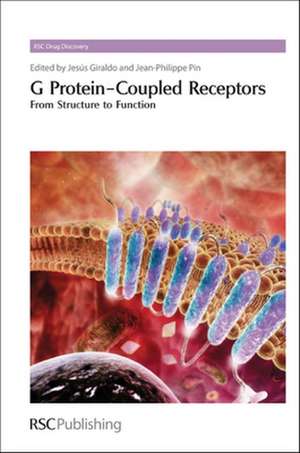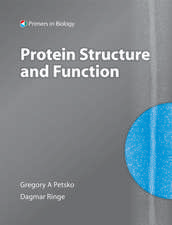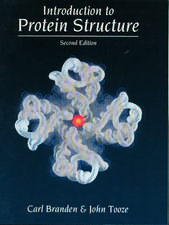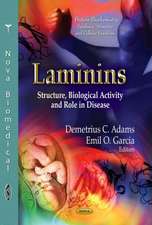G Protein-Coupled Receptors: RSC Drug Discovery, cartea 8
Ana Martinez Editat de Jesus Giraldo, Jean-Philippe Pinen Limba Engleză Hardback – 29 aug 2011
G protein-coupled receptors (GPCRs) are the largest family of cell-surface receptors, with more than 800 members identified thus far in the human genome. They regulate the function of most cells in the body, and represent approximately 3% of the genes in the human genome. These receptors respond to a wide variety of structurally diverse ligands, ranging from small molecules, such as biogenic amines, nucleotides and ions, to lipids, peptides, proteins, and even light. Ligands (agonists and antagonists) acting on GPCRs are important in the treatment of numerous diseases, including cardiovascular and mental disorders, retinal degeneration, cancer, and AIDS. It is estimated that these receptors represent about one third of the actual identified targets of clinically used drugs. The determination of rhodopsin crystal structure and, more recently, of opsin, 1 and 2 adrenergic and A2A adenosine receptors provides both academia and industry with extremely valuable data for a better understanding of the molecular determinants of receptor function and a more reliable rationale for drug design. GPCR structure and function constitutes a hot topic. The book, which lies between the fields of chemical biology, molecular pharmacology and medicinal chemistry, is divided into three parts. The first part considers what receptor structures tell us about the mechanism of receptor activation. Part II focuses on receptor function. It discusses what the data from biophysical and mutational studies, and the analysis of the interactions of the receptor with ligands and regulator proteins, tell us about the process of signal transduction. The final part, on modelling and simulation, details new insights on the link between structure and mechanism and their implications in drug design.
Din seria RSC Drug Discovery
- 14%
 Preț: 1227.21 lei
Preț: 1227.21 lei - 27%
 Preț: 2320.97 lei
Preț: 2320.97 lei - 5%
 Preț: 1548.26 lei
Preț: 1548.26 lei - 5%
 Preț: 1146.35 lei
Preț: 1146.35 lei - 5%
 Preț: 1137.19 lei
Preț: 1137.19 lei - 14%
 Preț: 1028.99 lei
Preț: 1028.99 lei - 5%
 Preț: 1139.05 lei
Preț: 1139.05 lei - 14%
 Preț: 1080.91 lei
Preț: 1080.91 lei - 14%
 Preț: 1195.25 lei
Preț: 1195.25 lei - 14%
 Preț: 1137.86 lei
Preț: 1137.86 lei - 5%
 Preț: 1372.96 lei
Preț: 1372.96 lei - 14%
 Preț: 1247.24 lei
Preț: 1247.24 lei - 9%
 Preț: 1067.08 lei
Preț: 1067.08 lei - 14%
 Preț: 1040.85 lei
Preț: 1040.85 lei - 14%
 Preț: 1163.73 lei
Preț: 1163.73 lei - 14%
 Preț: 1247.53 lei
Preț: 1247.53 lei - 5%
 Preț: 1554.98 lei
Preț: 1554.98 lei - 14%
 Preț: 1359.11 lei
Preț: 1359.11 lei - 5%
 Preț: 1529.80 lei
Preț: 1529.80 lei - 14%
 Preț: 1381.56 lei
Preț: 1381.56 lei - 5%
 Preț: 1440.92 lei
Preț: 1440.92 lei - 5%
 Preț: 1138.48 lei
Preț: 1138.48 lei - 5%
 Preț: 1535.29 lei
Preț: 1535.29 lei - 14%
 Preț: 1383.21 lei
Preț: 1383.21 lei - 14%
 Preț: 1389.84 lei
Preț: 1389.84 lei - 5%
 Preț: 1497.68 lei
Preț: 1497.68 lei - 14%
 Preț: 1033.62 lei
Preț: 1033.62 lei - 14%
 Preț: 1134.26 lei
Preț: 1134.26 lei - 5%
 Preț: 1240.14 lei
Preț: 1240.14 lei - 5%
 Preț: 1239.41 lei
Preț: 1239.41 lei - 14%
 Preț: 947.56 lei
Preț: 947.56 lei - 14%
 Preț: 777.54 lei
Preț: 777.54 lei - 14%
 Preț: 1136.40 lei
Preț: 1136.40 lei - 14%
 Preț: 1241.40 lei
Preț: 1241.40 lei - 5%
 Preț: 1499.54 lei
Preț: 1499.54 lei - 5%
 Preț: 886.61 lei
Preț: 886.61 lei - 5%
 Preț: 964.69 lei
Preț: 964.69 lei - 5%
 Preț: 1052.42 lei
Preț: 1052.42 lei - 9%
 Preț: 1006.32 lei
Preț: 1006.32 lei - 9%
 Preț: 1068.34 lei
Preț: 1068.34 lei - 9%
 Preț: 764.06 lei
Preț: 764.06 lei - 9%
 Preț: 1110.78 lei
Preț: 1110.78 lei - 5%
 Preț: 1160.18 lei
Preț: 1160.18 lei - 5%
 Preț: 1157.58 lei
Preț: 1157.58 lei - 5%
 Preț: 1158.08 lei
Preț: 1158.08 lei - 5%
 Preț: 1157.13 lei
Preț: 1157.13 lei - 9%
 Preț: 1211.73 lei
Preț: 1211.73 lei - 5%
 Preț: 1120.15 lei
Preț: 1120.15 lei
Preț: 1321.37 lei
Preț vechi: 1536.48 lei
-14% Nou
Puncte Express: 1982
Preț estimativ în valută:
252.92€ • 274.82$ • 212.59£
252.92€ • 274.82$ • 212.59£
Carte disponibilă
Livrare economică 31 martie-14 aprilie
Preluare comenzi: 021 569.72.76
Specificații
ISBN-13: 9781849731836
ISBN-10: 1849731837
Pagini: 548
Ilustrații: 108 black & white illustrations
Dimensiuni: 158 x 240 x 37 mm
Greutate: 0.91 kg
Editura: Royal Society Of Chemistry
Seria RSC Drug Discovery
ISBN-10: 1849731837
Pagini: 548
Ilustrații: 108 black & white illustrations
Dimensiuni: 158 x 240 x 37 mm
Greutate: 0.91 kg
Editura: Royal Society Of Chemistry
Seria RSC Drug Discovery
Cuprins
Section I: GPCR crystal structures on the arena; Structure and mechanism of G protein signalling through crystal structures of rhodopsin; Mechanism of receptor activation through the crystal structures of the ligand-free GPCR opsin;Crystal structure of the human ß2 adrenergic G-protein-coupled receptor; Crystal structure of a ß 1 adrenergic G-protein-coupled receptorCrystal structure of a human A2A adenosine receptor bound to an antagonist; Class A GPCRs: Structural analysis of the binding domain of follicle stimulating hormone receptor; Class B GPCRs: Receptor activation involving ligand binding to two receptor domains; Class C GPCRs: Structures of the extracellular regions of metabotropic glutamate receptors; Section II: GPCRs are multifaceted functional machines; G protein-coupled receptor homo- and hetero-dimerization: contribution to pharmacology and function; Detection of heteromers formed by combinations of three different receptors; Cross-talk between ionotropic and metabotropic glutamate receptors; Structural and functional basis of the crosstalk between receptors; GPCRs assemble as oligomers in the membrane, however a monomeric receptor is sufficient for G protein activation; Optical techniques to analyze real-time activation and signaling of G-protein-coupled receptors; Molecular basis of agonism revealed by fluorescence resonance energy studies; Metabotropic glutamate receptors: A paradigm of structural and functional receptor complexity; Lipid-protein interactions in GPCR-associated signaling; The role of cholesterol in GPCR signaling; Cholesterol-dependent GPCR signaling efficacy; Modulating receptor function through RAMPs: can they represent drug targets in themselves?; GRK2 Activation by Receptors; GRK2-Dependent Desensitization Downstream of G Proteins; Arrestins as multi-functional signaling adaptors; Enzyme regulation of -Arrestin-dependent signalling and trafficking of GPCRs; Section III: Modelling GPCR structure and function; Analyzing the activation mechanism of GPCRs by biophysical and computational methods; Modelling the activation mechanism of free fatty acid receptor 1; Prediction of opioid receptor oligomerization; Structural and dynamic effects of cholesterol at preferred sites of interaction with rhodopsin identified from molecular dynamics simulations; Quantifying GPCR function; Mathematical modelling of metabotropic glutamate receptors function; Modelling of G-protein-coupled receptor signaling pathways; From Structure to function to drug discovery: the view-point of a medicinal chemist
Recenzii
Drug discovery and development requires the active collaborations of researches from many scientific disciplines and sub-disciplines and the RSC has created a great opportunity to provide the necessary range of publications to facilitate this.
Professor Robin Ganellin, University College, London, UK
Notă biografică
Jesús Giraldo is based at the Institut de Neurociències and Unitat de Bioestadística, Universitat Autònoma de Barcelona. He works mainly in the field of mathematical modelling of GPCRs and has collaborated with a number of experimentalists, some of them leaders in the GPCR field. This has given him a deep understanding of the relationships between theory and experimentation in the area and a holistic view of the topic. Jean-Philippe Pin got his PhD in Molecular Biology from the University of Montpellier 2, France. He participated in the discovery of the metabotropic glutamate receptors and demonstrated synergism between various glutamate receptor subtypes for the activation of phospholipase A2. Subsequently, he worked as a post doctoral fellow at the Salk Institute where he cloned and characterized new mGlu receptor splice variants. In 1992, he set up a research team working on the structure function relationship of mGlu receptors in the CNRS laboratory in Montpellier. Currently, he heads the Molecular Pharmacology Department within the Institute of Functional Genomics, Montpellier, France where his research focuses on the molecular and cellular dynamics of GPCRs and has led to major new concepts in the GPCR field.
Textul de pe ultima copertă
G protein-coupled receptors (GPCRs) constitute the largest family of cell-surface receptors, with more than 800 members identified thus far in the human genome. They regulate the function of most cells in the body, and represent approximately 3% of the genes in the human genome. These receptors respond to a wide variety of structurally diverse ligands, ranging from small molecules, such as biogenic amines, nucleotides and ions, to lipids, peptides, proteins and even light. Ligands (agonists and antagonists) acting on GPCRs are important commonly used in drug therapy of numerous diseases, including cardiovascular and mental disorders, retinal degeneration, cancer, and AIDS. It is estimated that these receptors represent about one third of the actual identified targets of clinically used drugs. This book, which lies between the fields of chemical biology, molecular pharmacology and medicinal chemistry, is divided into three parts. The first part considers what receptor structures tell us about the mechanism of receptor activation. Part II focuses on receptor function. It discusses what the data from biophysical and mutational studies, and the analysis of the interactions of the receptor with ligands and regulator proteins, tell us about the process of signal transduction. The final part, on modelling and simulation, details what new insights on the link between structure and mechanism can be provided by theoretical studies and their implications in drug design. The various chapters present an update on the latest developments in GPCR structures and detailed structural changes linked to activation. They cover the latest news of the extraordinary complex function of these receptors, concentrating on the many aspects that are currently revolutionizing our current views of these proteins: receptor constitutive activity, receptor oligomerization, functional selectivity, biased agonism, multiple signalling pathways, multiple accessory proteins, functional cross talk and the mechanism of signal integration. This complex picture is tackled from complementary experimental and theoretical approaches, which represent a clear statement of our current knowledge of the GPCR complexity.
Descriere
G protein-coupled receptors (GPCRs) are the largest family of cell-surface receptors, with more than 800 members identified thus far in the human genome. The book lies between the fields of chemical biology, molecular pharmacology, and medicinal chemistry.













